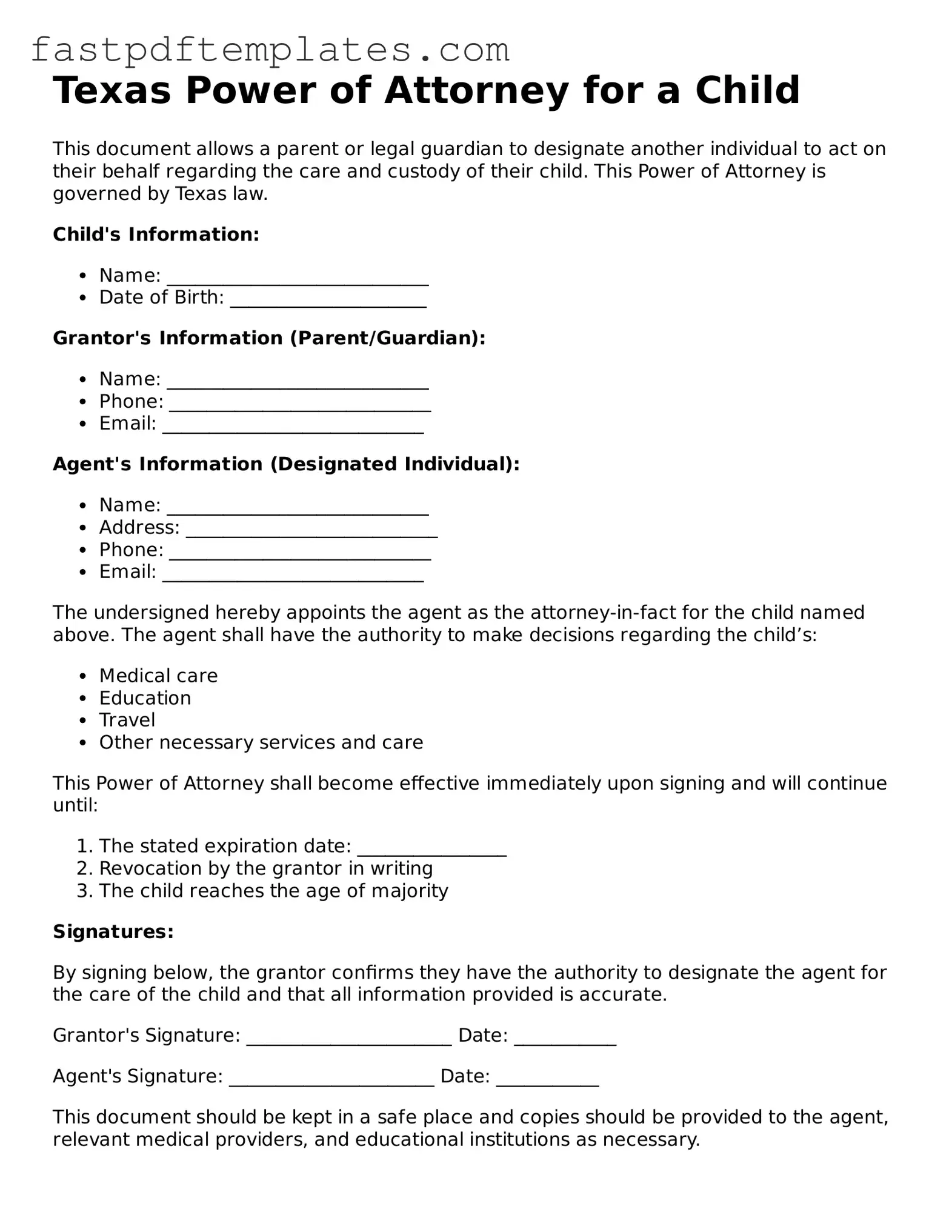The Texas Medical Power of Attorney is a document that allows individuals to appoint someone to make medical decisions on their behalf if they become unable to do so. Similar to the Power of Attorney for a Child, this form emphasizes the importance of appointing a trusted individual to act in critical situations. Both documents ensure that the appointed person can make decisions that align with the principal's wishes, reflecting a commitment to safeguarding health and well-being.
The Durable Power of Attorney is another related document. It grants authority to an agent to manage financial affairs on behalf of the principal. Like the Power of Attorney for a Child, this document remains effective even if the principal becomes incapacitated. This similarity highlights the importance of having a reliable representative who can act in the best interest of the principal, whether it pertains to financial or caregiving decisions.
The Limited Power of Attorney provides specific powers to an agent for a defined purpose or period. This document shares a commonality with the Power of Attorney for a Child in that it allows for the delegation of authority for particular tasks. Both forms empower individuals to designate someone they trust to handle specific responsibilities, ensuring that their needs are met without granting broad authority.
The Child Custody Agreement outlines the responsibilities and rights of parents or guardians regarding a child's care. This document relates to the Power of Attorney for a Child as both address the welfare of a minor. Each document serves to establish a framework for decision-making, with the Power of Attorney focusing on appointing a representative to act in the child's best interests during specific circumstances.
The Guardianship Application is a legal process that allows a person to be appointed as a guardian for a minor or incapacitated adult. This document parallels the Power of Attorney for a Child in that both involve the appointment of a responsible individual to care for someone else. However, guardianship typically involves more permanent arrangements, while the Power of Attorney can be more temporary and specific to certain needs.
The Affidavit of Parentage establishes a legal relationship between a parent and child. This document is similar to the Power of Attorney for a Child in that it affirms parental rights and responsibilities. Both documents emphasize the importance of recognizing and formalizing the roles of individuals who are entrusted with a child's care and decision-making.
The Adoption Agreement is a legal document that formalizes the adoption process. It shares similarities with the Power of Attorney for a Child in that both involve the transfer of parental rights and responsibilities. Each document aims to protect the child's best interests, ensuring that they are cared for by individuals who are committed to their well-being.
The Foster Care Agreement outlines the terms under which a child is placed in foster care. Similar to the Power of Attorney for a Child, this document focuses on the child's welfare and the responsibilities of the caregiver. Both forms highlight the importance of ensuring that children are placed in safe and nurturing environments, with designated individuals responsible for their care.
The Special Needs Trust is a financial arrangement that provides for the care of individuals with disabilities. This document is akin to the Power of Attorney for a Child in that it ensures that the needs of a vulnerable individual are met. Both documents reflect the importance of having a designated person or entity responsible for making decisions that enhance the quality of life for those who require additional support.
The Release of Liability Waiver is a document that protects individuals or organizations from legal claims. While it serves a different purpose, it shares a connection with the Power of Attorney for a Child in that both can involve decisions made on behalf of a minor. Each document seeks to clarify responsibilities and protect the interests of those involved, whether in caregiving or liability contexts.
